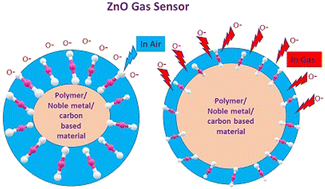Zinc oxide based gas sensors and their derivatives: a critical review
Abstract
The most extensively explored gas sensors are metal oxide semiconductor (MOS) materials owing to their high selectivity, stability, cost-effectiveness, and simple synthesis techniques. This review is based on the state-of-the-art experimental findings of ZnO based gas sensors for enhanced selectivity and sensitivity at low operating temperatures as well as at room temperature. Elevated operating temperatures have become the bottleneck of its extensive applications in the field of real-time gas monitoring due to increased energy consumption and shortening of the lifetime of the sensors. Therefore, the current review mainly focuses on ZnO based sensors operating at low temperatures. There are several effective strategies to attain low temperature enhanced sensing performance in ZnO materials by surface modification and additive doping, including the use of noble metals, carbon-based materials, polymer doping, and also by using composite materials. Thus, it is necessary to evaluate the accomplishments of ZnO sensors in the field of sensor technology, and this systematic review is suitable for understanding and identifying the challenges that they face. Our review will support researchers in studying highly sensitive and selective ZnO based gas sensors, and is followed by suggestions of future research interests and directions of these materials.

- This article is part of the themed collection: Journal of Materials Chemistry C Recent Review Articles


 Please wait while we load your content...
Please wait while we load your content...